 W
WThe Continued Top 100 Japanese Castles is a list of 100 castles, intended as a sequel of Top 100 Japanese Castles. The castles were chosen for their significance in culture, history, and in their regions by the Japanese Castle Foundation in 2017.
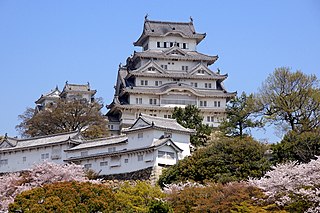 W
WThe castles in Japan's Top 100 Castles were chosen based on their significance in culture, history, and in their regions by the Japanese Castle Foundation in 2006.
 W
WAkō Castle is a flatland castle located in Akō, Hyōgo Prefecture, Japan. The castle is a nationally designated Historic Site and its gardens a Place of Scenic Beauty.
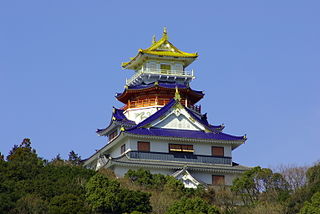 W
WAzuchi Castle was one of the primary castles of Oda Nobunaga located in Omihachiman, Shiga Prefecture.
 W
WBanna-ji (鑁阿寺) is a Buddhist temple of the Shingon sect in the city of Ashikaga, Tochigi Prefecture, in northern Kantō region of Japan. The honzon of the temple is a statue of Dainichi Nyōrai, leading to the temple's nickname of Dainichisama,. The temple is built on the ruins of the ancestral fortified residence of the Ashikaga clan who ruled Japan during the Muromachi shogunate, and its grounds are a National Historic Site
 W
WHikone Castle is a Japanese Edo-period castle in the city of Hikone, in Shiga Prefecture. It is considered the most significant historical building in Shiga. Hikone is one of only 12 Japanese castles with the original keep, and one of only five castles listed as a national treasure.
 W
WHirado Castle was the seat of the Matsura clan, the daimyō of Hirado Domain, of Hizen Province, Kyūshū. It is located in present-day Hirado city Nagasaki Prefecture, Japan. It was also known as Kameoka Castle .
 W
WHirosaki Castle is a hirayama-style Japanese castle constructed in 1611. It was the seat of the Tsugaru clan, a 47,000 koku tozama daimyō clan who ruled over Hirosaki Domain, Mutsu Province, in what is now central Hirosaki, Aomori Prefecture, Japan. It was also referred to as Takaoka Castle .
 W
WIwakuni Castle is a castle in Iwakuni, Yamaguchi, Japan.
 W
WKakegawa Castle is a hirayama-style Japanese castle. It was the seat of various fudai daimyō clans who ruled over Kakegawa Domain, Tōtōmi Province, in what is now central Kakegawa, Shizuoka Prefecture, Japan.
 W
WKanayama Castle was a Sengoku period yamashiro-style (castle located on top of Mount Kanayama in what is now the city Ōta, Gunma Prefecture, Japan. The site has been protected as a National Historic Site since 1990. The castle was also known as Ōta Kanayama Castle or as Nitta Kanayama Castle,
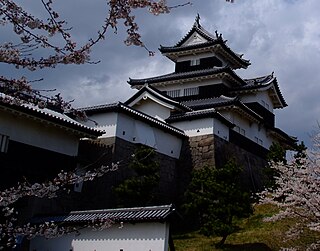 W
WKomine Castle is a Japanese castle located in what is now the city of Shirakawa, southern Fukushima Prefecture, Japan. Throughout the middle to later Edo period, Komine Castle was home to the Abe clan, daimyō of Shirakawa Domain. It was also referred to as Shirakawa-Komine Castle or simply Shirakawa Castle . The castle is one of the 100 Fine Castles of Japan, and in 2007 was designated a National Historic Site. It should not be confused with the older Shirakawa Castle also located in Shirakawa, Fukushima, also known as Karame-jō (搦目城) or Yūki-Shirakawa-jō (結城白川城). The castle grounds are also a noted venue for viewing sakura in spring.
 W
WKomoro Castle is a Japanese castle located in the city of Komoro, central Nagano Prefecture, Japan. At the end of the Edo period, Komoro Castle was home to a junior branch of the Makino clan, daimyō of Komoro Domain. It was also known as Ana-jō or Hakatsuru-jō . Today, it is open to public as Kaikoen(懐古園).
 W
WKumamoto Castle is a hilltop Japanese castle located in Chūō-ku, Kumamoto, in Kumamoto Prefecture. It was a large and well fortified castle. The castle keep is a concrete reconstruction built in 1960, but several ancillary wooden buildings remain of the original castle. Kumamoto Castle is considered one of the three premier castles in Japan, along with Himeji Castle and Matsumoto Castle. Thirteen structures in the castle complex are designated Important Cultural Property.
 W
WMaruoka Castle is a hirayama-style Japanese castle located in the Maruoka neighbourhood of the city of Sakai, Fukui Prefecture, in the Hokuriku region of Japan. It also called Kasumi-ga-jō due to the legend that whenever an enemy approaches the castle, a thick mist appears and hides it. Built at the end of the Sengoku period, the castle was occupied by a succession of daimyō of Maruoka Domain under the Edo period Tokugawa shogunate. The site is now a public park noted for its sakura. The castle’s relatively small tenshu claims to be the oldest in the country, a claim which is challenged by both Inuyama Castle and Matsumoto Castle.
 W
WMatsusaka Castle was a Japanese castle located in Matsusaka, Mie Prefecture, Japan. Throughout most of the Edo period, Matsusaka Castle was a secondary administrative center for the Kishu-Tokugawa clan, daimyō of Kishū Domain. The site has been proclaimed a National Historic Site by the Japanese government.
 W
WMatsushiro Castle is a Japanese castle located in former Matsushiro town, now part of the city of Nagano, northern Nagano Prefecture, Japan. At the end of the Edo period, Matsushiro Castle was home to the Sanada clan, daimyō of Matsushiro Domain. The site is a registered National Historic Site of Japan by the Japanese government.
 W
WMorioka Castle is a hirayama-style Japanese castle constructed in 1611. It was the seat of the Nanbu clan, a tozama daimyō clan who ruled over Morioka Domain, Mutsu Province in the Tōhoku region of northern Japan during the Edo period Tokugawa shogunate. The castle is located in what is now the center of the city of Morioka, Iwate Prefecture, Japan. It was also referred to as Kozukata Castle , but strictly speaking this name pertains to the predecessor of Morioka Castle on the same site.
 W
WNagashino Castle was a Sengoku period Japanese castle located in what is now Shinshiro, eastern Aichi Prefecture, Japan. It is noteworthy as the site of the crucial Battle of Nagashino between the combined forces of Tokugawa Ieyasu and Oda Nobunaga against Takeda Katsuyori in 1575. The site has been protected by the central government as a National Historic Site since 1929, the first time a former castle site had received such protection.
 W
WNanao Castle was a Muromachi period yamajiro-style Japanese castle located in what is now the city of Nanao, Ishikawa Prefecture, in the Hokuriku region of Japan. It is protected by the central government as a National Historic Site.
 W
WNe Castle is a Muromachi period Motte-and-bailey-style Japanese castle located in what is now the city of Hachinohe, Aomori Prefecture, in the Tōhoku region of far northern Japan. It has been protected by the central government as a National Historic Site since 1941. It was extensively reconstructed in 1994.
 W
WNihonmatsu Castle is a Japanese castle located in what is now the city of Nihonmatsu, northern Fukushima Prefecture, Japan. Throughout most of the Edo period, Nihonmatsu Castle was home to the Niwa clan, daimyō of Nihonmatsu Domain. The castle was also known as "Kasumi-ga-jō" (霞ヶ城) or "Shirahata-jō" (白旗城). The castle is one of the 100 Fine Castles of Japan, and in 2007 was designated a National Historic Site. The castle grounds are also a noted venue for viewing sakura in spring.
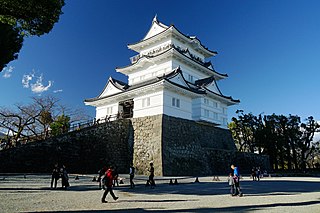 W
WOdawara Castle is a landmark in the city of Odawara in Kanagawa Prefecture, Japan.
 W
WOkazaki Castle is a Japanese castle located in Okazaki, Aichi Prefecture, Japan. At the end of the Edo period, Okazaki Castle was home to the Honda clan, daimyō of Okazaki Domain, but the castle is better known for its association with Tokugawa Ieyasu and the Tokugawa clan. The castle was also known as "Tatsu-jō " (龍城).
 W
WSaga Castle is a Japanese castle located in Saga City, Saga Prefecture, Japan. It is a hiraijirō, a castle built on a plains rather than a hill or mountain, and is surrounded by a wall rather than being built above a stone base. Saga castle was home to the Nabeshima clan, daimyō of Saga Domain. It was also known as "Submerged Castle" .
 W
WSasayama Castle is a Japanese castle in Tamba-Sasayama, Hyōgo, Japan.
 W
WShibata Castle is a flatland-style Japanese castle located in the city of Shibata, Niigata Prefecture, Japan. Throughout the Edo period, Shibata Castle was home to the Mizoguchi clan, daimyō of Shibata Domain. The castle was also known as "Ayame-jō" .
 W
WShimabara Castle , also known as Moritake Castle and Takaki Castle , is a Japanese castle located in Shimabara, Hizen Province. This five-story white building stands in stark contrast to the black Kumamoto Castle in neighboring Kumamoto Prefecture.
 W
WSunpu Castle was a Japanese castle in Shizuoka City, Shizuoka Prefecture in Japan. The sobriquet of this feudal fortress was the "Castle of the Floating Isle". It was also referred to as Fuchu Castle or Shizuoka Castle .
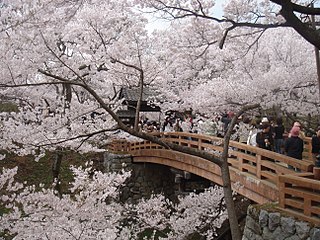 W
WTakatō Castle is a Japanese castle located in the city of Ina, southern Nagano Prefecture, Japan. At the end of the Edo period, Takatō Castle was home to a cadet branch of the Naitō clan, daimyō of Takatō Domain. The castle was also known as Kabuto Castle . Built sometime in the 16th century, it is now largely ruins.
 W
WTsutsujigasaki Castle was the fortified residence of the final three generations of the Takeda clan, located in what is now the city of Kōfu, Yamanashi Prefecture, Japan. It is not a castle in the proper sense of the word, and is not referred to as a "castle" in Japanese, as it was famously the policy of the Takeda clan to "make men your castle, men your walls, men your moats". Nevertheless, it is listed as one of Japan's Top 100 Castles. The site has been protected by the central government as a National Historic Site since 1938. The site is open to the public and now contains the Takeda Shrine, a Shinto shrine dedicated to the deified spirits of the Takeda clan.
 W
WTsuyama Castle is a castle in Sange, Tsuyama, Okayama prefecture, Japan. Tsuyama is home to one of Japan's three major hirayama style castles along with Himeji Castle and Matsuyama Castle (Iyo), which were constructed around the same time. During the Edo period, Tsuyama castle served as the primary residence of the government official and Lord of the Tsuyama Domain.
 W
WUeda Castle is a Japanese castle located in Ueda, northern Nagano Prefecture, Japan. At the end of the Edo period, Ueda Castle was home to a cadet branch of the Matsudaira clan, daimyō of Ueda Domain, but the castle is better known for its association with the Sengoku period Sanada clan. It was also called Amagafuji-jō or Matsuo-jō.
 W
WYamanaka Castle was a Sengoku period yamajiro-style Japanese castle, built by the Odawara Hōjō clan in Tagata District, Izu Province, in what is now eastern Mishima, Shizuoka Prefecture, Japan. The site has been protected by the central government as a National Historic Site since 1988.